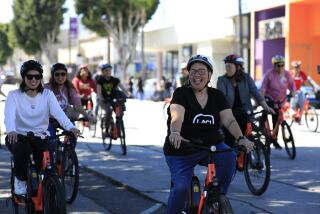Brake-Less Bikes Put Messengers on Fast Track
- Share via
DENVER — David Dungan dashes through midday traffic, changing lanes and blowing through red lights at almost 35 mph. A bicycle messenger, he does this five days a week in sun, wind, snow and rain.
And he does it all on a bike with neither gears nor brakes.
Dungan is one of a growing cadre of so-called “groovy” riders who have stormed onto the bike messenger scene everywhere from midtown Manhattan to San Francisco.
They ride “track bikes,” which are light, fast and increasingly evident in such cold-weather cities as Chicago, Boston and New York, where subzero temperatures can freeze brakes and snap cables.
But are they a good idea on the street, crowded with cars and pedestrians?
“My first month, I must have run into a dozen things,” the 23-year-old Dungan said. “But right now, I’d feel uncomfortable riding anything else.”
“It’s really taking off,” says Erek Hancock, a six-year veteran of the Boston-based Quicksilver Messenger Service Inc., who estimates half of the riders in Boston now use track bikes, compared with about 20% five years ago. “It’s the cool thing to do.”
Track bikes have a shorter wheelbase than ordinary bikes for making tight turns and use a fixed gear instead of a derailleur. The pedals move when a bike moves, forward or backward, and the only way to slow a track bike down is to pedal slower. A good rider can stop pedaling altogether, sending the bike into a kind of controlled skid.
“That’s why track bikes are so cool,” Dungan said. “You can slide and turn at the same time. I can switch three lanes while I’m sliding.”
The bikes were originally built for a velodrome, an oval track with steeply banked turns that features high speeds and crowded fields, according to Dale Hughes of the Walden School of Cycling in Rochester, Mich.
Hughes said the brakes were removed from track bikes long ago for safety reasons. “You’ve got 30 guys all elbow-to-elbow going 30 mph and nobody can stop in front of you” because nobody has brakes, he said.
Hughes insists track bikes are also safe on city streets. He argues that because messengers know they can’t stop fast, they’re more likely to choose a route that doesn’t get them into trouble, steering clear of cars and people that could slow them down.
Track bikes, he said, are becoming more popular all around. But he suggests it’s taking root among bike messengers specifically because of the risk.
“It’s more of a cavalier attitude, the Pony Express ‘get there at all costs’ sort of thing,” he said. “I am sure it’s a big rush to be going quick through traffic and you’ve got to make a quick decision, like, where’s my escape route? You’re on the edge out there.”
By their nature, bike messengers are independent types. No national group keeps records on what kind of bike each messenger rides. But a movement in Boston is trying to bring some order to the business.
The city took action in July following an accident in which a 62-year-old Federal Reserve Bank vice president fell into a coma after being hit by a bike messenger. A city licensing system for messengers took effect Jan. 1.
Riders in Boston must now carry picture identification and license plates behind their seats and have personal liability insurance. The idea is to create accountability, according to Boston Police Lt. James Curran.
“We’re not trying to knock them out of business,” he said. “We’re trying to bring them into compliance.
“Track bikes are something we’re going to have to look into,” he said.
There’s another benefit for track bike riders. Nelson George, a two-year messenger veteran in Boston with Quicksilver, says his bike gets stolen at least once every six months. But the thieves never get far.
“They only get about two blocks before they crash because they don’t know how to ride it,” he said.
More to Read
Sign up for The Wild
We’ll help you find the best places to hike, bike and run, as well as the perfect silent spots for meditation and yoga.
You may occasionally receive promotional content from the Los Angeles Times.






